人教版高中英语必修4:unit4 body language using language
- 格式:ppt
- 大小:2.59 MB
- 文档页数:32
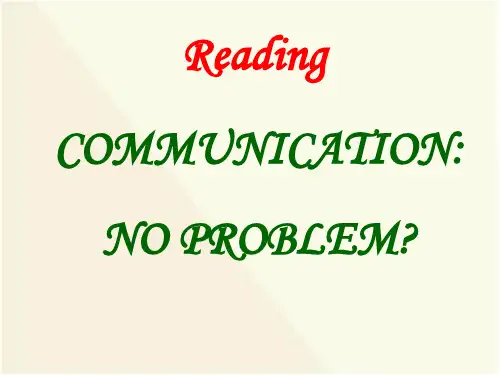
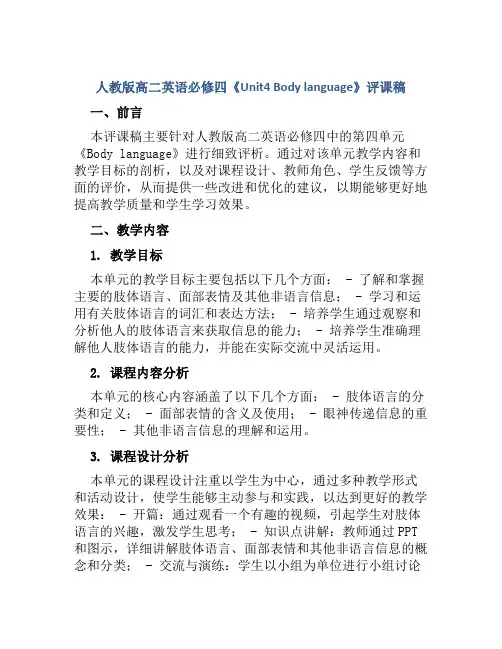
人教版高二英语必修四《Unit4 Body language》评课稿一、前言本评课稿主要针对人教版高二英语必修四中的第四单元《Body language》进行细致评析。
通过对该单元教学内容和教学目标的剖析,以及对课程设计、教师角色、学生反馈等方面的评价,从而提供一些改进和优化的建议,以期能够更好地提高教学质量和学生学习效果。
二、教学内容1. 教学目标本单元的教学目标主要包括以下几个方面: - 了解和掌握主要的肢体语言、面部表情及其他非语言信息; - 学习和运用有关肢体语言的词汇和表达方法; - 培养学生通过观察和分析他人的肢体语言来获取信息的能力; - 培养学生准确理解他人肢体语言的能力,并能在实际交流中灵活运用。
2. 课程内容分析本单元的核心内容涵盖了以下几个方面: - 肢体语言的分类和定义; - 面部表情的含义及使用; - 眼神传递信息的重要性; - 其他非语言信息的理解和运用。
3. 课程设计分析本单元的课程设计注重以学生为中心,通过多种教学形式和活动设计,使学生能够主动参与和实践,以达到更好的教学效果: - 开篇:通过观看一个有趣的视频,引起学生对肢体语言的兴趣,激发学生思考; - 知识点讲解:教师通过PPT 和图示,详细讲解肢体语言、面部表情和其他非语言信息的概念和分类; - 交流与演练:学生以小组为单位进行小组讨论和角色扮演,运用所学的肢体语言及表情,进行交流和演练;- 学习资源拓展:提供相关阅读材料和视频资源,供学生自主学习和拓展。
三、教师角色分析1. 课前准备教师在教学前应充分准备,并具备深入了解和掌握本单元内容的能力,以便能够传递给学生有效的知识和技能。
2. 授课过程中在正式授课过程中,教师应发挥引导者和组织者的作用,注重学生的主体性和参与性,通过引发学生思考、提问、讨论等方式,激发学生的学习兴趣和积极性。
同时,教师还应在学生实践活动中进行指导和点评,及时帮助学生纠正错误。
3. 课后总结教师应对本节课的教学效果进行总结和评估,及时调整和改进教学策略,为后续的教学提供参考。
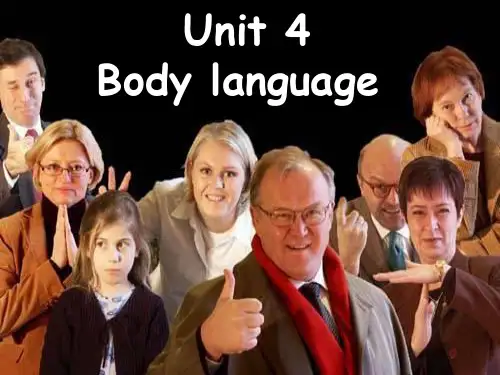
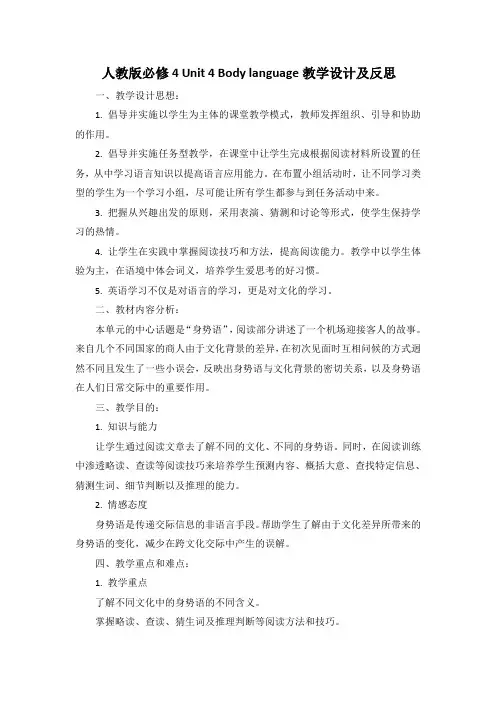
人教版必修4 Unit 4 Body language教学设计及反思一、教学设计思想:1. 倡导并实施以学生为主体的课堂教学模式,教师发挥组织、引导和协助的作用。
2. 倡导并实施任务型教学,在课堂中让学生完成根据阅读材料所设置的任务,从中学习语言知识以提高语言应用能力。
在布置小组活动时,让不同学习类型的学生为一个学习小组,尽可能让所有学生都参与到任务活动中来。
3. 把握从兴趣出发的原则,采用表演、猜测和讨论等形式,使学生保持学习的热情。
4. 让学生在实践中掌握阅读技巧和方法,提高阅读能力。
教学中以学生体验为主,在语境中体会词义,培养学生爱思考的好习惯。
5. 英语学习不仅是对语言的学习,更是对文化的学习。
二、教材内容分析:本单元的中心话题是“身势语”,阅读部分讲述了一个机场迎接客人的故事。
来自几个不同国家的商人由于文化背景的差异,在初次见面时互相问候的方式迥然不同且发生了一些小误会,反映出身势语与文化背景的密切关系,以及身势语在人们日常交际中的重要作用。
三、教学目的:1. 知识与能力让学生通过阅读文章去了解不同的文化、不同的身势语。
同时,在阅读训练中渗透略读、查读等阅读技巧来培养学生预测内容、概括大意、查找特定信息、猜测生词、细节判断以及推理的能力。
2. 情感态度身势语是传递交际信息的非语言手段。
帮助学生了解由于文化差异所带来的身势语的变化,减少在跨文化交际中产生的误解。
四、教学重点和难点:1. 教学重点了解不同文化中的身势语的不同含义。
掌握略读、查读、猜生词及推理判断等阅读方法和技巧。
2. 教学难点对文章内容进行推理判断的能力及在实践中运用阅读技巧的能力。
五、教学方法:任务型教学问答讨论六、学法指导:教师在教学中渗透一些阅读方法,如略读和查读等。
七、教学步骤:Step 1 LeadinProvide some students with several pieces of paper on which some directions are written. For example:1. Show gestures for“Well done / OK / Be quiet / Stop”.2. Show expressions for being “happy / sad / frightened / angry / proud”.The students are asked to make a demonstration of those actions with body language.【设计说明】这项任务旨在通过学生的参与并以游戏的形式来展现和导入本单元的主题——Body language,不仅能提高学生对所学内容的兴趣,充分起到了热身的作用,而且能使学生通过对旧知识的回顾从而自然过渡到对新知识的学习上来。
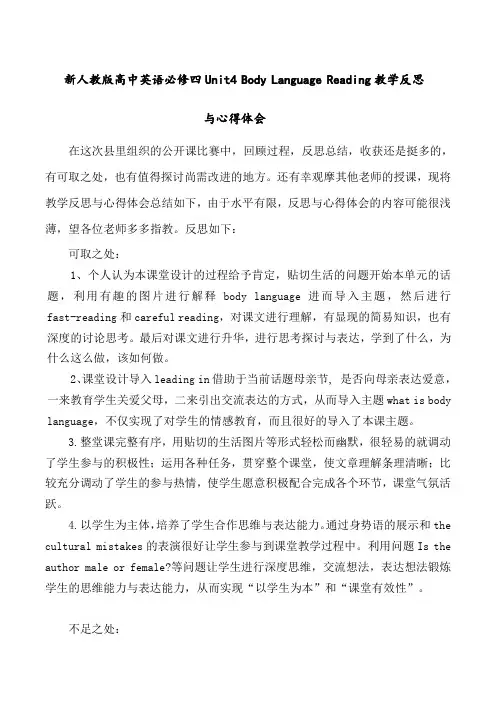
新人教版高中英语必修四Unit4 Body Language Reading教学反思与心得体会在这次县里组织的公开课比赛中,回顾过程,反思总结,收获还是挺多的,有可取之处,也有值得探讨尚需改进的地方。
还有幸观摩其他老师的授课,现将教学反思与心得体会总结如下,由于水平有限,反思与心得体会的内容可能很浅薄,望各位老师多多指教。
反思如下:可取之处:1、个人认为本课堂设计的过程给予肯定,贴切生活的问题开始本单元的话题,利用有趣的图片进行解释body language 进而导入主题,然后进行fast-reading和careful reading,对课文进行理解,有显现的简易知识,也有深度的讨论思考。
最后对课文进行升华,进行思考探讨与表达,学到了什么,为什么这么做,该如何做。
2、课堂设计导入leading in借助于当前话题母亲节, 是否向母亲表达爱意,一来教育学生关爱父母,二来引出交流表达的方式,从而导入主题what is body language,不仅实现了对学生的情感教育,而且很好的导入了本课主题。
3.整堂课完整有序,用贴切的生活图片等形式轻松而幽默,很轻易的就调动了学生参与的积极性;运用各种任务,贯穿整个课堂,使文章理解条理清晰;比较充分调动了学生的参与热情,使学生愿意积极配合完成各个环节,课堂气氛活跃。
4.以学生为主体,培养了学生合作思维与表达能力。
通过身势语的展示和the cultural mistakes的表演很好让学生参与到课堂教学过程中。
利用问题Is the author male or female?等问题让学生进行深度思维,交流想法,表达想法锻炼学生的思维能力与表达能力,从而实现“以学生为本”和“课堂有效性”。
不足之处:1. 学生思考的广度不够,阅读中停留在reading for information较多,而缺少reading for thinking,教学过程中基本上基于信息找寻的问题居多,而进行深入思考的的问题过少而且范围狭窄。
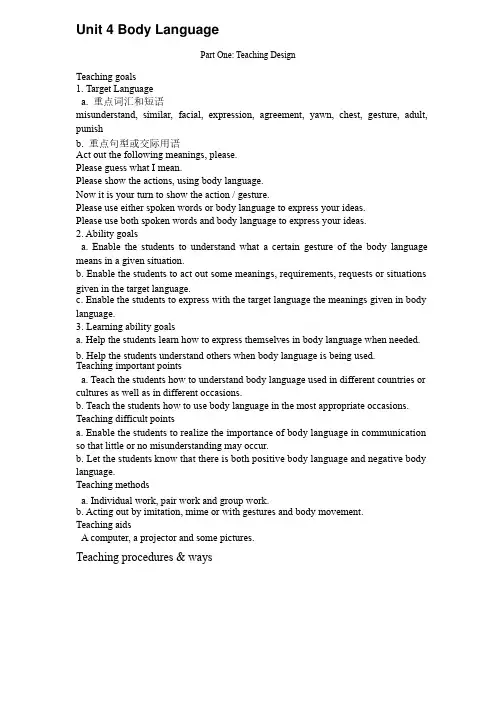
Unit 4 Body LanguagePart One: Teaching DesignTeaching goals1. Target Languagea. 重点词汇和短语重点词汇和短语misunderstand, similar, facial, expression, agreement, yawn, chest, gesture, adult, punishb. 重点句型或交际用语重点句型或交际用语Act out the following meanings, please.Please guess what I mean.Please show the actions, using body language.Now it is your turn to show the action / gesture.Please use either spoken words or body language to express your ideas.Please use both spoken words and body language to express your ideas.2. Ability goalsa. Enable the students to understand what a certain gesture of the body language means in a given situation.b. Enable the students to act out some meanings, requirements, requests or situations given in the target language.c. Enable the students to express with the target language the meanings given in body language.3. Learning ability goalsa. Help the students learn how to express themselves in body language when needed.b. Help the students understand others when body language is being used.Teaching important pointsa. Teach the students how to understand body language used in different countries or cultures as well as in different occasions.b. Teach the students how to use body language in the most appropriate occasions. Teaching difficult pointsa. Enable the students to realize the importance of body language in communication so that little or no misunderstanding may occur.b. Let the students know that there is both positive body language and negative body language.Teaching methodsa. Individual work, pair work and group work.b. Acting out by imitation, mime or with gestures and body movement.Teaching aidsA computer, a projector and some pictures.Teaching procedures & waysThe first period reading(COMMUNICATION: NO PROBLEM?)AimsTo help students develop their reading ability.To help students learn about body language.ProceduresI. Warming upWarming up by actingLook at the list of interpretation on the right side of the chart. Perform the action or the nonverbal behaviour on the left side.Examples Of Body LanguageWarming up by defining—What is body language?II. Pre-reading1. Looking and sayingLook at the man in the picture below. What does he say to you by his body language?Basically, how the ...... do I know? Or, I don’t know nothin! The shoulders are hunched and the hands are open signifying a big question mark.2. Talking and sharingBody language is the quiet, secret and most powerful language of all!According to experts, our non-verbal language communicates about 50% of what we really mean (voice tonality contributes 38%) while words themselves contribute a mere 7%.Our bodies send out messages constantly and often we don't recognize that we're communicating a lot more than we realize.Our understanding and use of non-verbal cues in facial expression are familiar to us nearly from birthIII. Reading1. Reading aloud to the recordingNow please listen and read aloud to the recording of the text COMMUNICATION: NO PROBLEM?. Pay attention to the pronunciation of each word and the pauses within each sentence. I will play the tape twice and you shall read aloud twice, too.2. Reading and underliningNext you are to read and underline all the useful expressions or collocations in the passage. Copy them to your notebook after class as homework.3. Reading to identify the topic sentence of each paragraphNext you are to skim the text to identify the topic sentence of each paragraph.4. Reading and transferring informationRead the text again to complete the table. Where is he/ she from? What does he/ she do when he/ she meet someone at the airport for the first time?Name Country Action MeaningMr GarciaJulia SmithAhmed AzizMadame Coulon5. Reading and understanding difficult sentencesAs you have read the text times, you can surely tell which sentences are difficult to understand. Now put your questions concerning the difficult points to me the teacher.6. Reading and translatingNow it’s time to translate the text into Chinese, sentence by sentence. Who will be the first to d o it?IV. Closing downClosing down by doing exercisesTo end the lesson you are to do the comprehending exercises No. 1 and 2 on page 26 and 27.Closing down by checkingC heck some of the following basic non-verbal cues and you'll recognize that you already speak and translate much of the language.“I’m surprised!” I’m shocked!” “I’m sad!”The second period Learning about Language(The ~ing form as the Attribute & Adverbial)I. Warming upWarming up by discovering useful words and expressionsTurn to page 27 and do exercises No. 1, 2 ,3 and 4 first. Check your answers against your classmates’.II. Learning about grammar1. Reading and thinkingTurn to page 25 and read with me the text of COMMUNICATION: NO PROBLEM? As you read along, pay attention to the uses of The ~ing form as the Attribute & Adverbial. (They are visitors coming from several countries. 作定语;Four people enter looking around in a curious way. 作状语;作状语; This is an exciting experience for you. 作定语; You stand watching and listening. 作状语;……)2. Doing exercises No. 1 and 2 on page 29Turn to page 29. Do exercises No. 1 and 2。
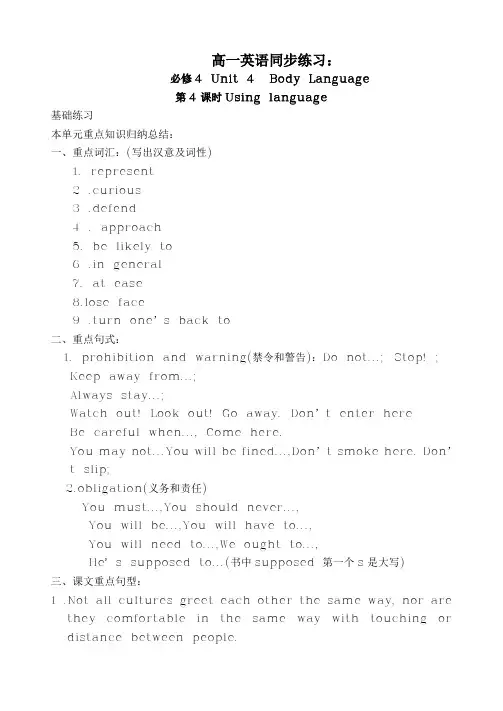
高一英语同步练习:必修4 Unit 4 Body Language第4课时Using language基础练习本单元重点知识归纳总结:一、重点词汇:(写出汉意及词性)1. represent______________2 .curious _______________3 .defend______________4 . approach ______________5. be likely to______________6 .in general______________7. at ease ______________8.lose face ______________9 .turn one’s back to______________二、重点句式:1. prohibition and warning(禁令和警告):Do not...; Stop! ;Keep away from...;Always stay...;Watch out! Look out! Go away. Don’t enter hereBe careful when..., Come here.You may not...You will be fined...,Don’t smoke here. Don’t slip;2.obligation(义务和责任)You must...,You should never...,You will be...,You will have to...,You will need to...,We ought to...,He’s supposed to...(书中supposed 第一个s是大写)三、课文重点句型:1 .Not all cultures greet each other the same way, nor arethey comfortable in the same way with touching or distance between people.1. 各种文化背景下的人互致问候的方式不尽相同,身体接触和相互间距的程度也不尽相同。
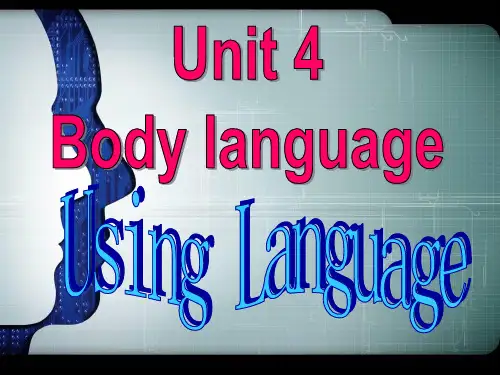

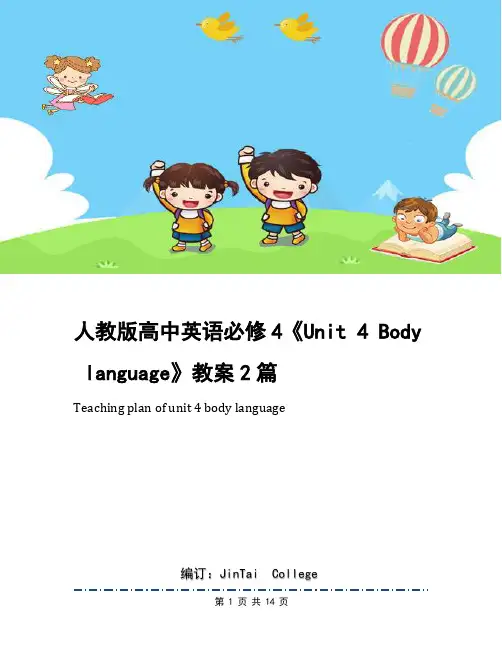
人教版高中英语必修4《Unit 4 Body language》教案2篇Teaching plan of unit 4 body language编订:JinTai College人教版高中英语必修4《Unit 4 Body language》教案2篇前言:英语作为在许多国际组织或者会议上都是必需语言,几乎所有学校选择英语作为其主要或唯一的外语必修课。
英语教学涉及多种专业理论知识,包括语言学、第二语言习得、词汇学、句法学、文体学、语料库理论、认知心理学等内容。
本教案根据英语课程标准的要求和教学对象的特点,将教学诸要素有序安排,确定合适的教学方案的设想和计划、并以启迪发展学生智力为根本目的。
便于学习和使用,本文档下载后内容可按需编辑修改及打印。
本文简要目录如下:【下载该文档后使用Word打开,按住键盘Ctrl键且鼠标单击目录内容即可跳转到对应篇章】1、篇章1:人教版高中英语必修4《Unit 4 Body language》教案2、篇章2:人教版高中英语必修4《Unit 4 Body language》教案篇章1:人教版高中英语必修4《Unit 4 Body language》教案教学准备教学目标1.教学目标(1)知识目标:学生能掌握下列重点单词和短语的意义和用法:greet, represent, approach, expression, defend, misunderstand, adult, cheek, major, likely, in general。
能够表达一些Body language.(2)能力目标:学生能掌握基本的阅读理解方法:速读,寻读,归纳中心和查找细节。
(3)情感目标:学生了解不同国家和文化的身势语,激发学生学习这种语言的兴趣。
教学重难点教学重点和难点(1)培养学生的阅读策略和技巧,让学生了解文章的细节知识和文章结构。
(2)让学生合适地使用不同的身势语。
(3)课文中现在分词作定语和状语的长难句。

高中英语教学设计教学重难点Teaching FocusMake the students understand that body language has cultural diversity and there is no division of good or bad for the diversity.ChallengeMake sure that the students will have the awareness to use and try to understand others’ body language when they communicate with others in the future.教学准备A. A projectorB. computer for multimedia teaching教学方法Teaching methodsA. Asking-and-answering between the teacher and the studentsB.. Interaction among individuals, pair-work and group-workC. Task-based teachingD. Teacher’s demonstration and interpretationE. Role-playingF. Students’ discovery教学过程设计活动内容Step 2介绍身势语的重要性A.Telling Students the Story of Tai Lihua and Making Them Know theImportance of Body Language in Her Life ( 3 min )1.Present the pictures of Thousands of Hands Kwan-yin , and ask the students whether they know thegirl who dances in the front.2. Tell the students tell life story of Tai Lihua and ask them the question “What are the key factors forher success in her life?”The life story of Tai LihuaHer name is Tai Lihua(邰丽华). She is called a Fairy of Peach blossom(桃花仙子) by people. You knowshe is a deaf girl, but she is a wise, diligent, charming and energetic girl. She studied very hard and got two degrees of bachelors in university. She was famous as an artist for her wonderful performance. She is deafand dumb. But how did she get that great achievement and became a successful person? She loves life very much. We should learn from her spirit. Besides her hard working, body language plays a very importantpart in her life. We are all healthy people, sometimes we can use body language to express ourselves. Sowe should pay more attention to learning body languages.B.Showing the Students the Science Report of the Importance Body Language,Making Them Know That Body Language Is As Important For Us As ForDisabled Person Like Tai Lihua. ( 1 min )Some psychologist believe that we communicate 65% of our ideas and feelings without words! The shape of our bodies and faces, the movements and gestures we make, the clothes we wear, how near we stand to each other and whether we touch each other…all these communicate. we must study all these types of information if we want to truly understand what other people are saying.Step 3介绍不同类型的身势语() ( step 3 will use around 5 min )A. Showing the Students The Four Types of Body LanguageGestureFacial expressionEye contactPostureB. Guessing The Meaning of GesturesThe teacher show the students a series of pictures of a man using different gestures, and the students are supposed to say their meaning.C.Acting Out By GesturesThe teacher show the students some English words and ask them to act them out together by using gestures.Victory!Ok !Be quiet!D. Chasing the Right WordThe teacher will show the students a series of pictures describing different facial expressions and askthe students to choose the right word for each.E. Matching the Right Interpretation Of the EyesThe teacher will present students several pictures of eyes and ask the students to match the right interpretation.You!Threatening No. sixThank you ! Congratulations!Facial expressionanger fear joy sorrow contempt轻视surprise disgust 厌恶What do you see in the eyes below?That’s a problem. I need to thinkfor while.a whileIt’s you! Let’s have a duel!That’s horrible! I’m terrified!The next minute,you’re a dead body!I’m in great sor rowness…I won’t give up! We’ll soon winback!F. Guessing The Meaning of Postures in Real ContextI give up!OK!You are asking help from this woman…You are saying “Will you give up!”…Give me a little time!I’m still thinking!You are asking this womanTo finish her work as soon as possible…You are asking this woman ”Have you got any good idea?” …I’m listening carefully!What do we know from their posture?Nice to meet you!This woman is listening to your ideas…You meet this man for the first time…G. Matching the Right Meaning of the Given Posturesnervous Bite your nails and fondle hair agreement Nod the head up and downBe not interested Look away or yawn.Do not believe Roll your eyes and turn your head away. angry Frown and turn your back to sb disagreement Shake the headStep 4给身势语下定义A.Finishing the First Question of Warming-up Part ( 3 min )The teacher will ask the students to discuss the question with your partner and try to find what the people in the pictures are communicating.B.Giving Definition To Body Language ( 2 min )The teacher will guide the students to give a general definition to body language.Body languageis a form of non-verbal communication.uses movements or positions of our body to show other people what we are thinking or feeling.mainly includes gesture, facial expression, eye contact, posture four forms.Step 5练习运用身势语A.Acting Out the Following words ( 4 min )This exercise is based on the second question of warming-up part. Two students will be chose to the frontof the class, and each of them will choose five words to act. After their action, other students will try to guess which word they have acted.•Hello!•Goodbye!•Go away!•Expensive!•I’m surprised!•I’m tired•I’m confused!•Good luck•I’m delighted!•I’m upset!•I’m sad!•I forgot!•You are great!•I’m curious!•I ate too much!•Come here!B.Acting Out the Dialogue on Page 67 ( 10 min )The student will work in groups of two to finish the speaking task of this unit on page 67. They are required to use appropriate body language as they are making dialogues. After their pairwork, volunteerswill make their dialogue before the whole class.Step 6介绍身势语的文化多样性A.Showing the Cultural Difference in Body Language With Examples ( 2 min )America OKJapan moneyFrance zeroBrazilGermanyrudeB . Presenting the Students the Major Greeting Customs in the World ( 2 min )Person and country Suitable greeting A man from ColumbiaTo a man: same as for a womanTo a woman: touches her shoulder and kissesher on the cheekA woman from BritainTo a man: not to close, shake hands To a woman: shake hands, will get closeA man from JapanTo a man: bowsTo a woman: bowsA man from CanadaTo a man: shake handsTo a woman: shake hands or kisses on both cheeks if knownA woman from FranceTo a man: shake hands, kisses twice on the cheekTo a woman: same to someone she knowsA man from the Middle East or some Muslim countriesTo a man:comes close, shakes handsTo a woman:nodsC. Discussion On the Question That If There is a Division of Good or Bad of the Different Meaning of The Same Body Language Under Different Culture.The students will have 3 minutes for discussion and after that some of them will represent their group to share their idea with the whole class.USA Nigeria rude Germany Japanone“great”or “good job”。
教学设计Step1 Leading-in1. Games:一名学生表演(without speaking),其他学生猜的游戏---导入“body language”的话题。
2. Brainstorm: “body language”的定义、种类、作用。
Q1: What parts of our body do we usually use to express ourselves.Q2: What’s body language and what’s its function?3. Prediction: 观察课文中的图片,学生预测课文内容:Where? What? Understand well?Step2 Reading1.ScanningTask1:Match the right main idea of each part.(详细内容见课件)Task2:The text is mainly about different ____________ in different countries.2. Detailed reading(1)Para.1Time:________________ People:___________________Place:_______________ What to do:___________________________ (2)Para.2&3 match different ways of greeting (详细内容见课件)拓展活动:1. act: 学生表演Tony Garcia和Julia Smith见面的场景。
2. 推理判断:根据第三段判断作者的性别。
(3)True or false1. Englishmen often stand close to others or touch strangers as soon as they meet.2. Most people around the world now greet each other by kissing .3. Japanese will bow to others as greeting.(4) Para5. Answer two questions:1. What does the author think of these actions?2. Should we learn some international customs? Why?Step3 Summary学生填空改写文章One student and I represented our school _______ (greet) the international students. At the airport, Tony from Colombia __________(approach) Julia from Britain and kissed her. _______, Julia stepped back appearing _______ (surprise). It seemed that they greeted each other ____ different ways. People communicate not only with _______ (speak) language, ______ through physical distance, actions or posture. These actions are simply different ______(culture) customs. ________ (study) these customs can help avoid ________(difficult) in communication.step4 Application--Problem-solving小组合作,完成任务。
Unit 4 Body LanguageUsing Language教学设计〔1〕Explore Body Language科目:英语课题:Using Language 课时:1课时教学目标与核心素养:知识目标:学习意群和停顿能力目标:引导学生关注听力中的内容信息和语境提示,按照说话人的逻辑推断没有直接表达的意义。
情感目标:体会肢体语言的表达魅力。
教学重难点教学重点:充分激活学生的背景知识,鼓励学生体验肢体语言的魅力。
教学难点:培养学生推断意义的能力,训练学生运用交际策略请求澄清和进行澄清。
课前准备:多媒体,黑板,粉笔教学过程:一、Pre-listening1. Greeting2. Leading-in教师活动:Let students look at the pictures in activity 1 and discuss what each person iscommunicating.二、While- listening听力理解1.学生活动:浏览活动3中的四个问题,明确听力任务。
学生活动:播放录音,指导学生完成活动3。
2.学生活动:听第二遍录音,完成活动4.要求在听懂的根底上进行合理推断并解释理由。
3.教师活动:引导学生分析对话的语言逻辑:提出——解释——回应——引出新话题——回应——提问——解释——引出新话题。
语音教学(1〕教师播放活动1的录音,让学生边听边关注每个句子中意群的划分和停顿。
〔2〕教师用幻灯片呈现没有划分意群的活动1中的长句,组织学生两人一组开展活动:小组中一人自己朗读没有划分意群的长句,另一个人认真记录同伴的停顿;然后两人交换角色。
接着,教师播放录音,全班跟读。
最后,以小组为单位讨论自己读的和录音的区别,并说一说划分意群的作用和规那么。
〔3〕教师引导学生模仿活动1对活动2的文本划分意群。
教师解释划分意群的根本规那么:Asentence can be divided into several sense groups according to the meaning, grammatical structures, and punctuation。
Part 11 Warming Up:1)What is body language?(spoken language, written language)T: do you know how many ways can we use to communicate with others in our daily life? It’s obvious that we could communicate with others by speaking, right? Except for speaking, also, we could communicate by the way of writing, what’s more, if we don’t use speaking and writing, we can choose to use our body language to convey information.T:OK, so do you know what is body language?Body language refers to various forms of nonverbal communication, which for a person may reveal clues as to some unspoken(无法言说,不言而喻的) intention or feeling through his physical behavior.2)look at the pictures on blackboard and discuss what are the meaning of these body languages.T: now I will show you some pictures about body language , and I hope you cold tell me the meaning of each picture, OK?T: you are so smart, and have you found the similarity of these body languages of each line, Yes, according to the given pictures, we could generally divided body language into three part:①body gesture ②body movement ③facial expressions3)Game: Conveying the information that is written on the cards to your partners with body language.And next, for better understanding and using body language, let us play a game, the players should act and guess the content of the cards. I will invite three groups to do the game here, four students a group, three perform, and one guess, clear?2 Pre-reading:1)A same body language maybe have different meaning in different countries.T:we all know that because of the different cultural background, a same body language maybe have very different meaning, such“OK”,in China, it means “yes”, but in Japan, it means “money”, in France, it means “nothing”, and in Italy it’s a impolite and dirty gestures.2)The same meaning could be conveyed by different body languages such as the way of greeting, what can the people do when they meet each other at the first time?T: A same body language maybe have different meaning, on the contrary, the same meaning also could be conveyed by different body languages such as the way of greeting, so what can the people do when they meet each other at the first time? T: We know in China, when we greet to someone at the first, we could shake or wave our hands right? but what are the ways in other more countries? Let us learn it from the reading material on textbook page 26.3 While-reading:1)Skin to find the main idea of this passageT: Now , I will give you three minutes to read the whole passage quickly and summarize the main idea, OK?(This passage shows body language differs from culture to culture. Not all people greet each other in the same way. So we should study international customs for better communication.)2)Fill the blank to find the ways to greet in different countries or areasOK, everybody, next I will give another five minutes to read the passage again and find out all the ways to greet others by using body language according to the blank4 Post-reading:1)Is the author male or female? How do you know that?T: OK, everyone, there is an inference question, “Is the author male or female? And how do you know that?”(male, because Ahmed Aziz only shake hands with men.2)Find out the two cultural mistakes in para 2.T:In para 2 the author has mentioned two cultural mistakes right? So the first is what? (when tony Garcia from Colombia, approached Julia Smith from Britain, touched her shoulder and kissed her on the cheek as greeting, however, Julia stepped back appearing surprised and put up her hands to defend)The second mistake is (George Cook, who came from Canada, reached his hand out to Akira Nagata from Japan for introducing himself, however, Akira bowed so his nose touched George’s hand)3)What can we learn from this text?T: Do you feel the embarrassed? , for decreasing this kind of cultural mistakes, what do we need to do?①Body language plays an important role in daily communication, so it is very important to understand and use it correctly.②We should study international customs and respect the different cultures in the world.③When in Rome, do as the Romans do.5 homework:Find more body languages differ from culture to culture.(4groups, one group finishes one together)Part 21 Review:Yesterday we’ve learned many body languages about greeting which is different in many cultures, still we can remember that, in Britain, people usually greet with shaking hands, ……And today we go further learn the body language which conveys an universal information.2 While-reading:T: Firstly, everybody please spends three minutes looking through the whole passage and finding the main idea, clear? OK, go ahead with your task.1)What is the main idea of the passage?T: Are you finished? Where can we find the main idea? Which paragraph?Some body languages or gestures are the same throughout the world.2)Fill the blank to summarize the feelings and the corresponding body languages T: So next, let us learn these body languages further and together, at the same moment, please find out the emotional meaning of each body language, clear?3)Discussion:T: All right, it has been quite clear to understand the same body language and its emotional meaning throughout the world. The last reading task, everybody please gives an example of a person whose body language is very impressive or important to you, and please tell the reasons.(4)Guess the order of the story on page 31, then listen to the tape of the story on page 65.T: So much for our reading , by this unit, we had learned a lot of body language as well as its cultural meaning and emotional meaning, right. OK, next it’s time to check your knowledge acquisition.4)Act one of the stories on page 31 and 65.3 Homework:Do the exercises in 三维设计。